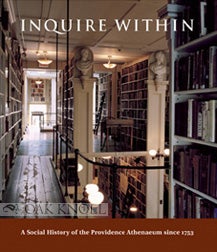Providence: The Providence Athenaeum, 2003. 9 x 10.5 inches. stiff paper wrappers. xxxvi, 219+(1) pages. First edition. An outstanding history of this most important historical and influential library. The Providence Athenaeum, 250 years old in 2003, not only played a significant role in defining the cultural, intellectual, and social life of Rhode Island in its early years, but played a major part in shaping America itself. Having withstood numerous wars, depressions, and high times alike..... READ MORE
Price:
$20.00
other currencies
Order nr. 73259
The Providence Library Is Incorporated, 1798
In the 1790s, with the United States Constitution finally ratified, Providence was on the move. New streets were being built, bridges spanned the Seekonk River, ships crowded the wharves, and produce wagons jostled for space outside the Market House. Partly because of the destruction of Newport by the British, the population of Providence surged from 4,355 at the beginning of the Revolutionary War to 7,614 in 1800.1 A lot of building took place, much of it west of the river, and what is now the city proper began to take shape. John Brown, to the evident admiration of the Duc de la Rochefoucauld, had recently "accomplished things that, even in Europe, would appear considerable." These "things" included digging through a hillside, building wharves and houses, and establishing a gin distillery, powered by oxen.
By 1798, with the postwar recession over, the China trade flourishing, and Slater Mill in production, the proprietors could really concentrate on the library. What they saw was an organization suffering badly from neglect and reduced circumstances. Few books had been purchased for a quarter century. Not only tea had been affected by patriotic fervor: the war stopped the importation of books from London and as yet few were printed in the Americas. Over the years numerous books had been lost and damaged. Between recalcitrant proprietors unwilling to pay their annual fees, care- less handling by Brown students and members of the General Assembly, vandalism, and general wear and tear, the library, which had boasted some 900 "well selected" books in its heyday, was now "much reduced, the setts broken and the Volumes mutilated and defaced."
In October 1798 a standing committee of library proprietors successfully petitioned the General Assembly for an act of incorporation. Jabez Bowen, Moses Brown, William Richmond, John Smith, Nicholas Brown II, Joseph Jenckes, and Paris Jenckes Tillinghast wanted more "power...to establish laws and ordinances"; they wanted the authority to make the proprietors pay their way. They also wanted to raise enough revenue to secure "a person qualified for the office" of librarian, an individual who would devote "such attention as would accommodate the Proprietors." This was neither the first nor last time that concerns about librarians' salaries would be raised.
Meanwhile, committee members tried to find the missing books. Seven men divided up the town between them. Merchants John Smith and Joseph Jenckes took the area north of the Weybosset Bridge; Captain Joseph Tillinghast, one of the leaders of the Gaspee raid, and Nicholas Brown II were responsible for the area south of the bridge; lawyer William Richmond and cotton merchant Paris Tillinghast took the west side of the river; while Jabez Bowen, a member of Brown's class of 1788, was to "apply at the College." A committee appraised the remaining books, which were valued at $560.88, and the library reopened in the State House on February 15, 1800.
The library needed an injection of funds, as well as of enthusiasm, so the directors decided to start a membership drive. There was an influx of new proprietors; forty shares changed hands between 1800 and 1805 and by 1808 fifty-two new shares had been sold. The directors were ingenious men anxious to increase their stock of books, and by 1801 they had decided that new subscribers could pay in kind for their shares. Among those who took advantage of this "shares for books" deal was Isaac Greenwood who donated five volumes of Millet's Ancient and Modern History, Zephaniah Andrews who delivered eight volumes of the English literary magazine the Spectator, and Job Danforth who gave two folio volumes of Burrough's Law Report. Thus several hundred new books were obtained! and the collections started to grow again.

